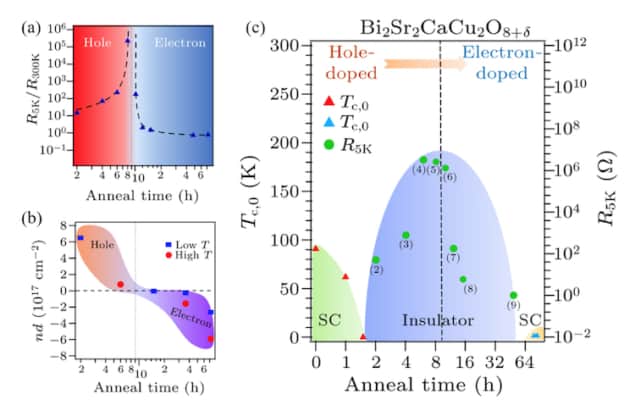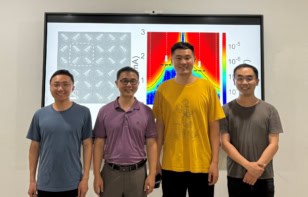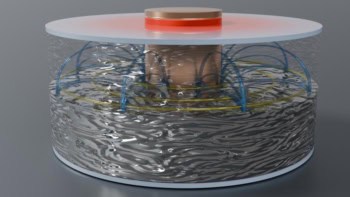
A new way of tweaking the composition of copper oxide-based superconductors could shed more light on their fundamental properties – including the mechanism responsible for their high-temperature superconductivity. The technique involves heating the superconductors for different periods of time and produces samples that are doped at different levels by changing their oxygen content. The type of doping can even be transformed from hole-doped to electron-doped – a change that was not possible with previous doping methods.
The classical (or BCS) theory of superconductivity states that, below a certain critical temperature, the fermionic electrons in a metal pair up with help from lattice vibrations to create bosons called Cooper pairs. These bosons form a phase-coherent condensate that can flow through a material without scattering – with superconductivity appearing as a consequence.
BCS theory does not explain the superconductivity of unconventional superconductors such as copper oxides (cuprates), pnictides and other exotic superconductors, however. While the resistance of a metal usually decreases as the material cools down, many of these unconventional superconductors experience a dramatic change in their electronic band structure that causes their resistance to decrease at temperatures above the critical temperature Tc. This change is known as a pseudogap and it may occur because electrons form pairs (although not a superconducting condensate) at temperatures above the critical temperature.
From hole- to electron-doped
In the new work, a team led by Hong Ding of the Beijing National Laboratory for Condensed Matter Physics and the Institute of Physics at the Chinese Academy of Sciences studied a typical hole-doped cuprate superconductor with the chemical formula Bi2Sr2CaCu2O8 + δ (Bi2212). The doping in this material is mainly determined by its oxygen content and conventional doping techniques can be used to regulate its hole doping level.
In their experiments, Ding and colleagues placed samples of Bi2212 in a quartz tube that contained powdered CaH2, which is a strong reducing agent. They then pumped the tube to vacuum and heated it to a fixed temperature with a tube furnace. They held the sample at this temperature for varying periods of time. This process, known as annealing, controls the doping level in the Bi2212.
“During the annealing, the hydrogen emanating from the CaH2 combines with oxygen in the Bi2212, forming water vapour,” Ding explains. “We found that the CaH2 is very effective at changing the valence of the copper in Bi2212.”
The new method of doping allowed them to change the oxygen content of the superconductor over a much wider range than was previously possible, and even to switch it from being hole-doped to electron-doped. And that is not all: the researchers say they also found evidence of a low-temperature superconducting phase in the electron-doped material.

Reducing agent controls doping in cuprate superconductor
Using a combination of X-ray diffraction, scanning transmission electron microscopy, and measurements of resistance and the Hall effect, the researchers confirmed that the topochemical reaction in the furnace is effective at changing the oxygen content of Bi2212. Ultra-low temperature transport analyses using a dilution refrigerator, which can reach as low as 10 mK, also revealed a sharp transition to a zero-resistance state (indicative of superconductivity) at around 1.4 K in the samples that were electron-doped.
In future work, the team says it will perform ARPES and STM measurements on these doped Bi2212 samples to find out how the material’s band structure, Fermi surface, superconducting gap and pseudogap evolve. “These studies will hopefully allow us to better understand high-Tc superconductors in general,” Ding tells Physics World.
The present work is detailed in Chinese Physics Letters.



